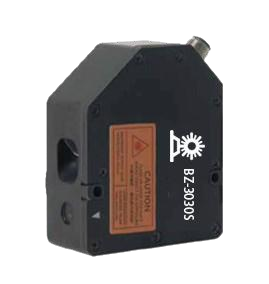Desc
Measurement principle:
When a beam of laser irradiates the measured object at a certain angle of incidence, the laser will reflect and scatter on the surface of the object. At this point, a lens can be used to converge and image the reflected laser onto the image sensor at another angle. When the measured object moves in the direction of the laser, the light spot on the image sensor will also move, and its displacement corresponds to the distance of the measured object's movement. From this, algorithm design can be used to calculate the movement distance of the measured object relative to the baseline.
Function Introduction:
① Adapt to multiple tested surfaces
The adaptive algorithm for light quantity will dynamically adjust parameters such as laser power and exposure time based on the measured surface return light, achieving a dynamic adjustment of 1000000:1 light quantity. Therefore, the product can adapt to measurements on different surfaces, such as glue, PCB, disc, ceramic, metal, etc.
② High speed and high sensitivity measurement performance
CMOS chips with high pixel width and number of pixels, combined with controllers with high-speed driving and low noise signal reading capabilities, can maximize the performance of displacement sensors. The measurement speed of up to 160 kHz and sub micron level measurement accuracy can meet the extreme measurement needs of objects such as piezoelectric ceramics.
③ High precision long-distance non-contact measurement is developed for the development of laser displacement sensors. The high-resolution objective lens can cause changes in the surface light spot of the measured object
Minimize the impact while reducing optical distortion. The measurement working distance can be selected within 30-1500mm, meeting the needs of various long-distance measurement scenarios such as high temperature and window limitations.
④ The highly reliable integrated sensor structure products have been validated and tested according to various international standards such as high and low temperatures, vibrations, and impacts, and can fully meet most industrial application scenarios. The commonly used industrial interfaces (RS485, analog output, etc.) can be directly connected from the probe, facilitating product integration into various industrial automation equipment.
⑤ Capable of measuring the size and displacement of micrometers, linear lasers are focused into regular elliptical light spots on the image sensor through an objective lens. A 30 micron sized spot can bring extremely high resolution and is crucial for measuring fine structures.
Related products
-

Point laser displacement sensor
Measurement principle: When a beam of laser irradiates the measured object at a certain angle of incidence, the laser will reflect and scatter on the surface of the object. At this point, a lens can be used to converge and image the reflected laser onto the image sensor at another angle. When the measured object moves in the direction of the laser, the light spot on the image sensor will also move, and its displacement corresponds to the distance of the measured object's movement. From this, algorithm design can be used to calculate the movement distance of the measured object relative to the baseline. -

3D Laser Profile Sensor
The laser module produces a line of laser light that is projected on the object surface, diffusely reflected by the object, imaged and captured by the image sensor. The image processor calculates the spatial position of the object where the laser is projected, and obtains the width information of the laser profile in the X direction and the depth information in the Z direction. According to he relative movement of the measured object and the sensor, a series of profile information is obtained for fusion, and the complete three-dimensional shape of the object can be obtained.

